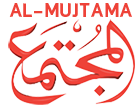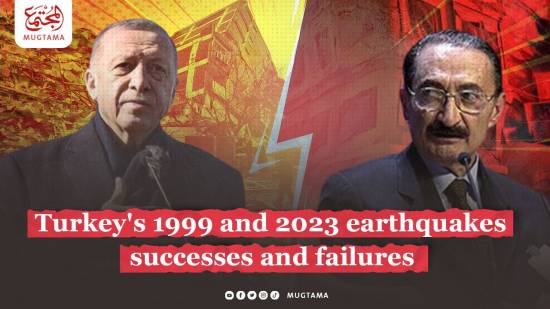Turkey's 1999 and 2023 earthquakes... successes and failures Featured
The latest quake, which lasted 65 seconds, is not the first to strike Turkey, which has been rocked by numerous earthquakes in the past. However, the latest earthquake is considered the deadliest in decades, and it brought back sad memories of the August 1999 Marmara earthquake, which had a magnitude of 7.6 and was centred in the Izmit region near Istanbul. It resulted in the deaths of thousands of people and significant devastation in various cities, including Istanbul.
And in an opinion article published by "Al-Mujtama" magazine, issue number: "1365": 20 Jamaad Awal 1420 AH - 31/8/1999 CE, entitled "The earthquake disaster puts Turkey at a crossroads. "A- Mujtama said that the catastrophe revealed the inability of the Turkish government at the time and revealed the spread of corruption, and moral and professional decline, especially in the construction sector.
At that time, the Turkish media talked about many contractors who were driven by the lust for profit to cheat building materials and underestimate the lives of citizens and expose them to the risk of death, and demanded that some of them be brought to trial, which confirms that the loss of consciences is more serious than the destruction of the facilities and buildings destroyed by the earthquake.
Only 45 seconds from the Marmara earthquake was enough for nearly 45,000 dead and injured, and half a million homeless people, in great pain amidst the wreckage, the smell of death, and the fear of the unknown.
Comparing the two earthquakes, the catastrophe that occurred in 1999 reveals the inability of the Turkish government, the Democratic Left Party headed by Bulent Ecevit at the time, which failed to deal with the consequences of the earthquake and to provide services, and government institutions were in a state of confusion and absent from the scene.
Turkish writer Ismail Pasha said, "The government of Bulent Ecevit came out in front of the cameras, hours after the earthquake occurred, to admit that it did not have sufficient information because it was unable to communicate with some areas due to the interruption of phone lines." The writer added that the tents that the Turkish Red Crescent Society sent to the cities hit by the earthquake at the time were very worn out and unusable."
Pasha noted that at the time, the Turkish government "asked support from foreign organizations, such as the International Red Cross, but failed to coordinate those organizations' operations." He stated, "The situation spurred civil society organizations, charities, and Islamic groups of various orientations to organize in order to assist the victims and meet their immediate needs, such as tents, food, clothing, medicines, and blankets. This public movement filled the void left by the administration."
Turkish government's efforts in the recent earthquake
No one can deny the success of the government of the Turkish Justice and Development Party in dealing with the recent disaster, and the mobilization of all its institutions to mitigate the effects of the earthquake and heal the wounds. In the recent earthquake that hit southern Turkey, the government was able to heal the wounds, so rescue teams moved to the area as soon as possible.
The Anadolu Agency stated that 31,254 Turkish search and rescue personnel and international teams are continuing their efforts in the earthquake zone, sheltering about one million and 50,000 affected citizens, in addition to 25,067 members of the armed forces working in the earthquake zone.
Also, the Turkish government was present on the ground from the first moments with all its institutions immediately after the disaster occurred to follow up the rescue operation and provide the required services to the population, led by the country's President Recep Tayyip Erdogan and his deputy Fuad Aktay.
The researcher on Turkish affairs, Saeed Al-Hajj, said in an article on the "Al-Jazeera Net" website: "We are facing two different scenes in time. The first, the rapid one, that is, immediately after the earthquake, in which the current government presented a completely different performance than the Marmara earthquake.
The concerned ministers were in the earthquake zone in the first hours, led by Vice President Fuad Oktay, who led the rescue operations himself.
He adds that the institutions worked in two simultaneous and complementary tracks. The Disaster and Emergency Control Authority (AFAD) led relief operations, including evacuation, shelter, rescue, guidance, etc., while the Ministry of Health took care of medical matters such as first aid, treatment, and health follow-ups, as well as blood donation and other requirements. Ministries and other institutions worked in coordination with them and under their command.
Al-Hajj suggested that the earthquake would have political repercussions no less important and dangerous than aftershocks, pointing out that the government's performance on the one hand and the opposition's claims, on the other hand, will be in a state of feverish competition to convince the Turkish people of the validity of this or that proposition.
And he continued, "With time, the current earthquake will impose itself as one of the important files in the context of the upcoming elections - along with the economy, foreigners, and others - for the ruling coalitions and the opposition, as well as other parties and the street alike, and in everyone's imagination the 1999 earthquake in terms of results and consequences, specifically the evaluation of the government's performance by citizens/voters.
Founding of "AFAD"
The Turkish government took into account the risks related to earthquakes, which prompted it, after the 1999 earthquake, to create the “Disaster and Emergency Authority” known as (AFAD), which was established in 2009 to prepare for dealing with natural disasters in the country, including earthquakes, and to coordinate with governmental and private institutions to supply areas affected by all the services it needs, in addition to participating in search and rescue operations.
AFAD's activities in providing relief to the afflicted extend outside the country. There are also other search and rescue teams affiliated with the Turkish Red Crescent Society, the Gendarmerie Forces, and some civil organizations such as the Turkish Relief Organization (IHH), working in coordination and cooperation with the "AFAD" teams.
In November 2022, the Turkish authorities conducted a test in all states and Northern Cyprus, for training in readiness to deal safely with earthquakes.
President Recep Tayyip Erdogan said, in a video speech: Turkey has tested its readiness for earthquakes by conducting 94,207 tests since the beginning of this year (2022).
A pioneering seismic station
Turkey is in a race against time to get ready for earthquakes and learn how to live securely in an earthquake-prone area in order to prevent significant losses in lives or properties. As a result, in the "Büyükçekmece" neighbourhood on Istanbul's European side, it inaugurated the first station to track earthquakes and tsunamis in June 2021.
This station is equipped with a number of measurement instruments that can read seismic data, estimate how far an earthquake would travel, determine if a tsunami will occur or not, and send an early warning before tsunami waves manifest, with a window of between 5-7 minutes.


